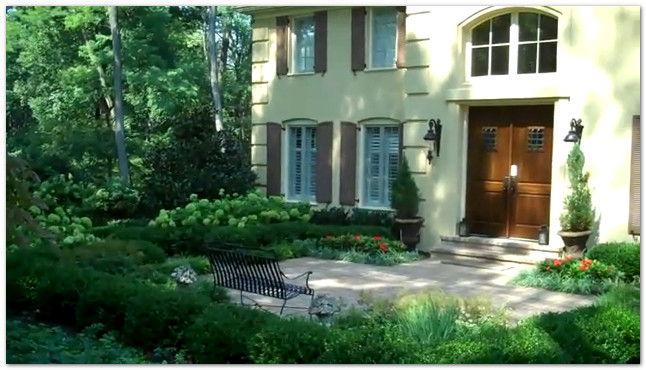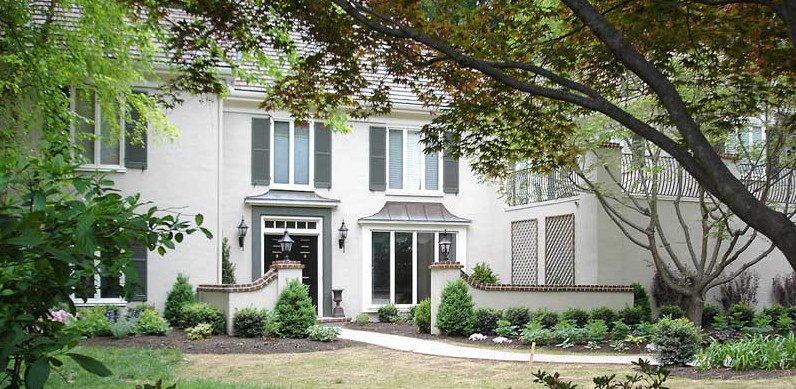Without a doubt, a formal courtyard presents an attractive and welcome space at the front of a home or in a side or backyard garden area, reminiscent of courtyards enjoyed by the finest European aristocracy. The formal courtyard entry provides instant impact, as if the first impression of your home heightens anticipation for further surprises yet to be discovered.
In possessing a beautifully gardened courtyard, one’s thoughts might resonate with the words of Robert Brault, who said, “I sit in my garden, gazing upon a beauty that cannot gaze upon itself. And I find sufficient purpose for my day.”
How does one accomplish this gardening masterpiece, creating the perfect blend of architectural features, hardscaping and landscaping? Structure is absolutely essential, as the sight line, or the immediate channel of vision one has when entering the courtyard, needs to be geometrically and architecturally well defined.
Plants and materials may vary according to taste and style, but the structural features must render a sense of stability, formality and uniformity. The following landscape design tips are offered as suggestions to whet the appetite of the Philadelphia homeowner interested in formal courtyard design by a Main Line landscape designer:
Enclosing the Courtyard
Enclosure is the most critical characteristic or design feature of the courtyard. Whether the landscape designer or architect selects walls, fencing or landscaping, the shape, height and material of the enclosure each contributes to the success of the final design. Courtyard boundaries may vary in height and be solid or transparent. The courtyard may be enclosed on all four sides, while even three sides are able to create a sense of enclosure.
In possessing a beautifully gardened courtyard, one might resonate with the words of Robert Brault, who said, “I sit in my garden, gazing upon a beauty that cannot gaze upon itself. And I find sufficient purpose for my day.”
Plant and Pathway Materials and Design
Pathways may be brick, stone, or other natural selections, and should be in balance with the rest of the courtyard. Focal points, such as urns filled with flowers, decorative birdbaths, and graceful statues, complement the paving or other materials in order to achieve a consistent sense of harmony. Formal hedging plants emphasize the overall shape and bring year round structure to the display, while plantings of annuals provide fresh and vibrant color. Flowering shrubs, roses and perennials are carefully selected to splash changing color through out the entire season. The expert landscape design plans incorporate drainage and erosion control strategies and materials as well.
Water features are a splendid addition to any courtyard, and are often the central feature around which the garden comes alive. The sound of splashing water is restorative and soothing, so providing a seating nook will allow passersby to enjoy the therapeutic effects in comfortable style.
According to HGTV.com, the hardscaping, walls and pathways in a formal garden create the structure. The designer comments about the sense of precision in a classical garden layout, “I think of hard materials as the bone structure of the garden, which the planting can soften and enhance.”
In business for over 35-years, full-service landscape design company Aardweg Landscaping of Newtown Square, PA was recently recognized with the “Best Of  Houzz” 2015 Award for Customer Satisfaction by Houzz, the leading platform for home remodeling and design. Are you interested in learning more about formal courtyard design at your Main Line or Philadelphia home? To schedule a complimentary on-site consultation, call Aardweg Landscaping at 610-355-0703, or send an email using the website contact form.
Houzz” 2015 Award for Customer Satisfaction by Houzz, the leading platform for home remodeling and design. Are you interested in learning more about formal courtyard design at your Main Line or Philadelphia home? To schedule a complimentary on-site consultation, call Aardweg Landscaping at 610-355-0703, or send an email using the website contact form.



